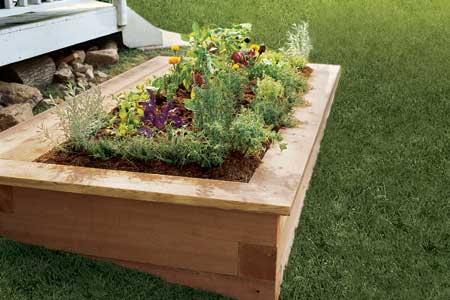Raised beds are an efficient way of growing vegetables and can be used for mini-vegetable plots, potagers and no-dig systems. In such a bed, the volume of soil is increased by adding organic matter so it is higher than the surrounding paths.
You can have just a single raised bed with brick sides linking the patio with the rest of the garden, or a series of beds separated by permanent paths. The paths are never dug, watered or fertilised, but provide access to the beds for sowing, planting and weeding. This means that all the organic matter, fertiliser and water can be concentrated on the growing area.
Because the beds are higher than the surrounding soil, they will warm up earlier in spring, drain quicker after rain and have a greater depth of soil for plant roots. The soil in raised beds does not need to be dug every year and can easily be converted into a no-dig system, which does away with digging completely.
Small beds lend themselves to planting in blocks or sowing a succession of short rows to spread the harvest. They are also easy to cover with garden fleece or fine mesh to protect the plants from frost or flying pests.
By edging raised beds and making permanent paths between them, you can turn them into an attractive feature
The choice of materials
Whether you opt for simple and practical rectangular beds or a more elaborate potager, there is a wide choice of materials to consider.
Paving slabs set on edge and half-buried will provide a permanent edging. Depending on the width of the slabs, you could build beds as high as 30cm above soil level. Bricks or paving blocks, either laid loose or cemented in, can create an attractive feature, especially if linked to the rest of the garden. Railway sleepers can be bought from specialist suppliers. They are heavy and hard to cut but provide solid edges to larger raised beds.
Gravel boards from fencing suppliers or builders’ merchants are the easiest material to use for edging. Most are pressure-treated with preservatives; if this worries you, look for untreated timber 15cm wide and 2.5cm deep. Old floorboards make an acceptable substitute and can often be salvaged from demolition sites.
How big?
Make the beds narrow enough that you can reach the centre from either side without stepping on the soil. About 1.2m is a workable width for most people. Beds should be no longer than 3m so they are easy to get round. Rectangular beds are the most efficient use of space. The paths should be a minimum of 30cm wide; 45cm is wide enough to allow access for a wheelbarrow, but any wider uses up valuable growing space.
Building a simple raised bed
Step 1 – Level the site and remove any perennial weeds. Mark out the shape of the bed with pegs and string, making sure it is square and level.
Step 2 – Hammer the posts into the corners. 60-cm lengths cut from 5- or 7.5-cm square fenceposts are ideal. Leave about 12.5cm of the posts above ground. If the sides will be longer than 2.4m, you may need to join boards together – position a post to reinforce the joint.
Step 3 – Cut lengths of gravel board to size and nail them to the posts with galvanised nails. Settle them into the soil and check the tops with a spirit level.
Step 4 – To save weeding the paths, lay down porous polypropylene membrane, and top with a layer of bark or gravel. Dig the soil inside the bed and add well-rotted organic matter.
After care
If you do all your planting and weeding from the paths and never walk on the bed, the soil should remain in peak condition and will not need digging each year. Add a generous layer of well-rotted organic matter every year or two. Mushroom compost is ideal, but stack it under a polythene cover for a couple of months to allow any chemicals in it to break down first. Not only will the compost suppress the weeds, but earthworms will mix it into the bed. Soon it will be possible to grow any crop without additional fertiliser.
Keep on top of weeds by hoeing or hand-weeding regularly. If you do not bring buried weed seeds to the surface by digging and prevent annual weeds seeding, the weeds should gradually decline. Keep beds occupied with vegetables, or use green manuresto help maintain soil structure.
Categories
Advertisements
Recent Articles
 How to Understand Bed Sizes – A Small Guide
How to Understand Bed Sizes – A Small Guide How to Select Some Must Have Kitchen Accessories
How to Select Some Must Have Kitchen Accessories Best Way to Change a Car Tire
Best Way to Change a Car Tire Best Way to Write an Affirmation
Best Way to Write an Affirmation Best Way to Take Charge of Your Financial Life
Best Way to Take Charge of Your Financial Life Best Way to Survive a Party When You Don’t Know Anyone
Best Way to Survive a Party When You Don’t Know Anyone Best Way to Stop Self Sabotaging Yourself
Best Way to Stop Self Sabotaging Yourself Best Way to Start Journal Writing
Best Way to Start Journal Writing Best Way to Speak with a Powerful Voice
Best Way to Speak with a Powerful Voice Best Way to Simplify Your Life
Best Way to Simplify Your Life Best Way to Respond to a Put-Down
Best Way to Respond to a Put-Down Best Way to Reduce Acne Breakouts
Best Way to Reduce Acne Breakouts Best Way to Recover from Dining Disasters
Best Way to Recover from Dining Disasters Best Way to Quit Your Job Gracefully
Best Way to Quit Your Job Gracefully Best Way to Make Your Own Website
Best Way to Make Your Own Website




Leave a Reply